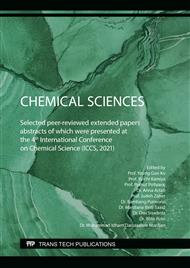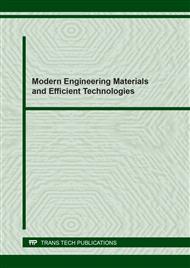[1]
M. Rafatullah, O. Sulaiman, R. Hashim, A. Ahmad, Adsorption of methylene blue on low-cost adsorbents: A review, J. Hazard. Mater. 177 (2010) 70–80.
DOI: 10.1016/j.jhazmat.2009.12.047
Google Scholar
[2]
M.A. Mohd Salleh, D.K. Mahmoud, W.A. Wan Abdul-Karim, A. Idris, Cationic and anionic dye adsorption by agricultural solid wastes: A comprehensive review, Desalination 280 (2011) 1–13.
DOI: 10.1016/j.desal.2011.07.019
Google Scholar
[3]
M. Fayazi, M.A. Taher, D. Afzali, A. Mostafavi, Enhanced Fenton-like degradation of methylene blue by magnetically activated carbon/hydrogen peroxide with hydroxylamine as Fenton enhancer, J. Mol. Liq. 216 (2016) 781–787.
DOI: 10.1016/j.molliq.2016.01.093
Google Scholar
[4]
E. Forgacs, T. Cserháti, G. Oros, Removal of synthetic dyes from wastewaters: A review, Environ. Int. 30 (2004) 953–971.
DOI: 10.1016/j.envint.2004.02.001
Google Scholar
[5]
K. Piaskowski, R. Świderska-Dąbrowska, P.K. Zarzycki, Dye removal from water and wastewater using various physical, chemical, and biological processes, J. AOAC Int. 101 (2018) 1371–1384.
DOI: 10.5740/jaoacint.18-0051
Google Scholar
[6]
C.R. Holkar, A.J. Jadhav, D.V. Pinjari, N.M. Mahamuni, A.B. Pandit, A critical review on textile wastewater treatments: Possible approaches, J. Environ. Manage. 182 (2016) 351–366.
DOI: 10.1016/j.jenvman.2016.07.090
Google Scholar
[7]
M.B. Ahmed, J.L. Zhou, H.H. Ngo, W. Guo, N.S. Thomaidis, J. Xu, Progress in the biological and chemical treatment technologies for emerging contaminant removal from wastewater: A critical review, J. Hazard. Mater. 323 (2017) 274–298.
DOI: 10.1016/j.jhazmat.2016.04.045
Google Scholar
[8]
G. Crini, Non-conventional low-cost adsorbents for dye removal: A review, Bioresour. Technol. 97 (2006) 1061–1085.
DOI: 10.1016/j.biortech.2005.05.001
Google Scholar
[9]
R.V. Kandisa, N. Saibaba, K.B. Shaik, R. Gopinath, Dye removal by adsorption: A review, J. Biorem. Biodegrad. 7 (2016) 1000371.
Google Scholar
[10]
I. Shah, R. Adnan, W.S. Wan Ngah, N. Mohamed, Y.H. Taufiq-Yap, A new insight into the physical interpretation of activated carbon and iron-doped carbon material: Sorption affinity towards organic dye. Bioresour. Technol. 160 (2014) 52–56.
DOI: 10.1016/j.biortech.2014.02.047
Google Scholar
[11]
T. Tsoncheva, I. Genova, B. Tsintsarski, M. Dimitrov, D. Paneva, Z. Zheleva, I. Yordanova, G. Issa, D. Kovacheva, T. Budinova, H. Kolev, R. Ivanova, I. Mitov, N. Petrov, Transition metal modified activated carbons from biomass and coal treatment products as catalysts for methanol decomposition, React. Kinet., Mech. Catal. 110 (2013) 281–294.
DOI: 10.1007/s11144-013-0612-z
Google Scholar
[12]
C.S. Castro, M.C. Guerreiro, L.C.A. Oliveira, M. Goncalves, A.S. Anastácio, M. Nazzarro, Iron oxide dispersed over activated carbon: Support influence on the oxidation of the model molecule methylene blue, Appl. Catal., A 367 (2009) 53–58.
DOI: 10.1016/j.apcata.2009.07.032
Google Scholar
[13]
A. Kumar, C. Patra, S. Kumar, S. Narayanasamy, Effect of magnetization on the adsorptive removal of an emerging contaminant ciprofloxacin by magnetic acid activated carbon, Environ. Res. 206 (2022) 112604.
DOI: 10.1016/j.envres.2021.112604
Google Scholar
[14]
F. Barjasteh-Askari, M. Davoudi, M. Dolatabadi, S. Ahmadzadeh, Iron-modified activated carbon derived from agro-waste for enhanced dye removal from aqueous solutions, Heliyon 7 (2021), e07191.
DOI: 10.1016/j.heliyon.2021.e07191
Google Scholar
[15]
H. Li, F. Cui, F. Zhang, J. Cui, Q. Meng, J. Cheng, Preparation and DEA removal performance using iron modified activated carbon, Int. J. Environ. Sci. Technol. 16, (2019) 2927–2936.
DOI: 10.1007/s13762-018-1854-0
Google Scholar
[16]
I. Shah, R. Adnan, A.G. Alsultan, Y.H. Taufiq-Yap, Catalytic conversion of waste cooking oil into biodiesel using functionally advanced recyclable iron impregnated activated carbon materials, J. Dispersion Sci. Technol. 0 (2020) 1–16.
DOI: 10.1080/01932691.2020.1850292
Google Scholar
[17]
I. Shah, R. Adnan, W.S. Wan Ngah, N. Mohamed, Iron impregnated activated carbon as an efficient adsorbent for the removal of Methylene Blue: Regeneration and kinetics studies, PLoS One 10 (2015) e0122603.
DOI: 10.1371/journal.pone.0122603
Google Scholar
[18]
N. Wang, T. Zheng, G. Zhang, P. Wang, A review on Fenton-like processes for organic wastewater treatment, J. Environ. Chem. Eng. 4 (2016) 762–787.
Google Scholar
[19]
Y. Liu, Y. Zhao, J. Wang, Fenton/Fenton-like processes with in-situ production of hydrogen peroxide/hydroxyl radical for degradation of emerging contaminants: Advances and prospects, J Hazard. Mater. 404 (2021) 124191.
DOI: 10.1016/j.jhazmat.2020.124191
Google Scholar
[20]
C. Jiang, S. Pang, F. Ouyang, J. Ma, J. Jiang, A new insight into Fenton and Fenton-like processes for water treatment, J. Hazard. Mater. 174 (2010) 813–817.
DOI: 10.1016/j.jhazmat.2009.09.125
Google Scholar
[21]
D. Meyerstein, Re-examining Fenton and Fenton-like reactions, Nat. Rev. Chem. 5 (2021) 595–597.
DOI: 10.1038/s41570-021-00310-4
Google Scholar




